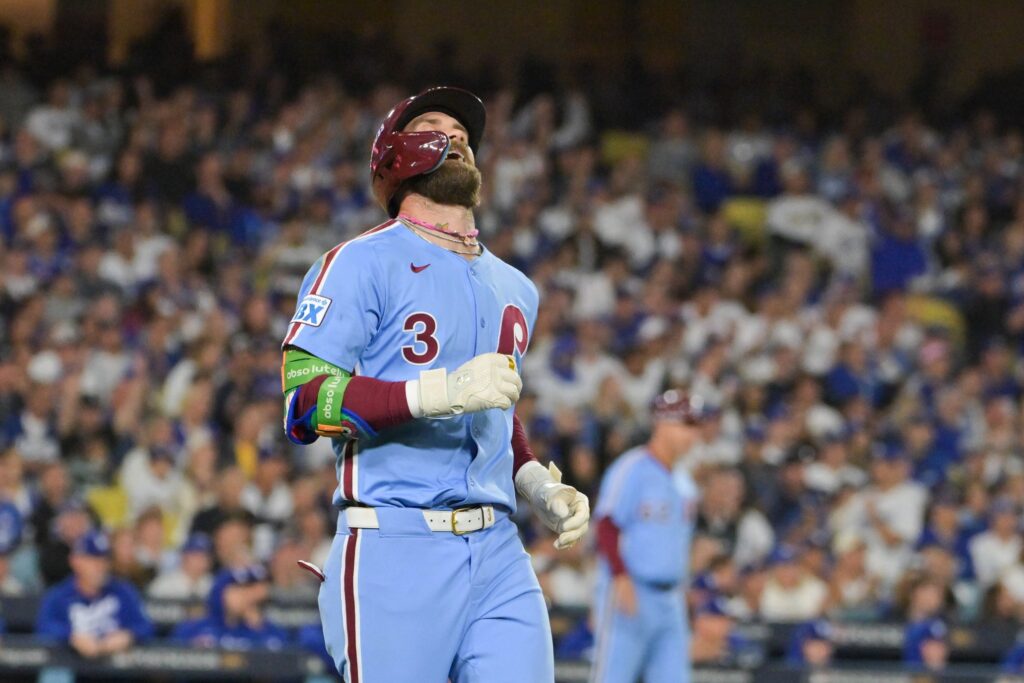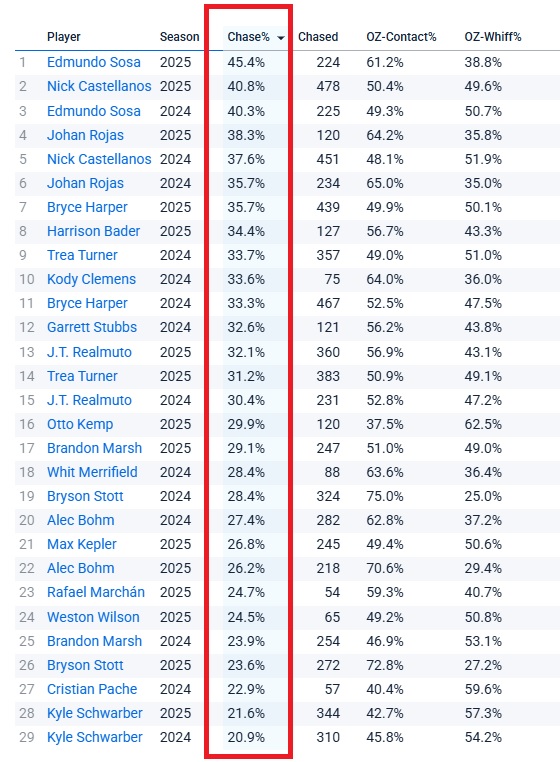Ad Disclosure
Philadelphia Phillies Chase Rate Update: The Final Numbers Look Awfully Familiar

In the end, it was the Phillies’ offense that came up short in the postseason.
This time, the pitching was excellent in the NLDS, but outside of a Game 3 explosion, the bats were mostly cold against the Dodgers.
Let’s take a look at the final chase numbers and see how much of a problem it was in another sad playoff exit:
Postseason
- 30.7 % chase rate (6th out of 12 teams)
- 95 total pitches chased
- 49.5% out-of-zone contact rate (11th)
- 50.5% out-of-zone whiff rate (2nd highest)
The postseason chase rate ended up being fine. Middle of the pack. The Dodgers, through the NLDS and NLCS, have actually chased at a 30.6% rate, which is 0.1% better than the Phillies.
Difference is, LA is making contact with 55.8% of the pitches they swing at outside of the zone, which is third-best in the postseason. The Phils are way down at 11th, so the rate itself is league-average, and nothing to write home about, it’s more that they whiffed about half of the time when they did chase.
For context, the Phils chased at a 32% rate in the 2024 playoffs and a 30% rate in 2023, so this is largely consistent over a three-year span. In each of those seasons, however, the out-of-zone whiff rate was bottom-three.
Regular season
- 30.4% chase rate (3rd highest in Major League Baseball)
- 3,703 total pitches chased (1st by a large margin)
- 54.1% out-of-zone contact rate (20th)
- 45.9% out-of-zone whiff rate (tied with the Nationals for 10th-highest)
Sure enough, the Phils’ chase rate ended up being almost exactly the same as it was in 2024. It increased from 30.3% to 30.4%. The out-of-zone contact and whiff rates were almost exactly identical as well. They went from 54.3% contact rate last year to 54.1% this year, so almost a negligible change.
The obvious team takeaway is that the Phillies largely were a carbon copy of their 2024 selves, though if you break it out individually, you get a chart looking like this:

The main thing that stands out here is that Nick Castellanos and Bryce Harper do a lot of chasing and a lot of missing at the same time. In the last two seasons, they’ve chased above 33% while hovering right around 50% for contact rate. In both cases, they chased more in 2025, while Nick’s whiff number slightly decreased and Bryce’s slightly increased.
On the other side of the spectrum. Bryson Stott continues to excel in this area. Not only does he chase at some of the lowest individual rates, but when he does chase, he makes contact at 74% on average over these past two years. Kyle Schwarber is also very disciplined here, with a caveat. He has the lowest chase rates on the team, below 22% both seasons, but when he does swing, he rarely makes contact, whiffing above 54% on average.
The numbers largely corroborate what your eyes are telling you. This was much of the same story as it was in 2024.
Now, we turn to the Eagles, Flyers, Sixers, Union, and we play blackjack online.
Kevin has been writing about Philadelphia sports since 2009. He spent seven years in the CBS 3 sports department and started with the Union during the team's 2010 inaugural season. He went to the academic powerhouses of Boyertown High School and West Virginia University. email - k.kinkead@sportradar.com